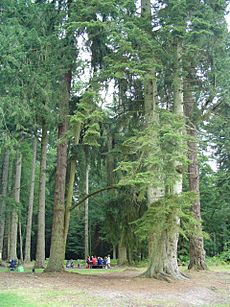Royal forest facts for kids
A royal forest was a special area of land, usually woodlands, that belonged to the king or queen in the past. It wasn't always just trees; it could also include open fields, grasslands, and wet areas. These lands were mainly used for hunting by the monarch and their noble friends.
In Anglo-Saxon England (from about 500 to 1066 AD), kings loved to hunt. However, they didn't set aside special areas where only they could hunt. Historians haven't found any proof that Anglo-Saxon kings created these "royal forests."

Things changed a lot after the Normans came to England in 1066. Under the Norman kings, no one was allowed to hunt on royal lands unless the king gave them permission. This rule was made to protect the "venison" (the animals, especially deer) and the "vert" (the green plants that fed them). The main animals hunted were red deer, fallow deer, roe deer, and wild boar.
Royal forests were created as private hunting grounds for the monarch or their invited aristocracy (rich and powerful people). This idea came from the Normans in the 11th century. By the late 12th and early 13th centuries, a huge part of southern England (about one-third of the land) was called a royal forest. For example, at one point in the 12th century, all of Essex was made a royal forest. When King Henry II became king, he declared all of Huntingdonshire to be a royal forest.
Creating these forests, especially the New Forest, caused some problems for local people. It meant that villages and farms inside these areas also had to follow the strict forest laws. People living there found it harder to use the land they had always relied on for their food and living. However, their basic rights to use the land for things like grazing animals were not completely taken away, just limited.
Forest Laws and Their End
Forest law had very strict rules for anyone who broke them inside the royal forests. If someone killed game animals without permission, it was considered a very serious crime with severe punishments.
Over time, these strict laws became less common. By the mid-17th century, the rules were not really enforced anymore. Even so, many woodlands in England today are still called "Royal Forests." The idea of setting aside land just for the king or queen was common across Europe during the medieval period.
What Was Inside a Royal Forest?
Royal forests were not just thick woods. They often included large areas of open land like heath (open, uncultivated land), grassland, and wetland (like marshes or bogs). These different types of land were important because they supported the deer and other game animals that the kings hunted.
Even if there were villages, towns, or farms inside an area that was declared a royal forest, those places and the people living there also had to follow the forest laws. This meant that local people had fewer rights to use the land for their own needs, even if they had lived there for generations. However, they still kept some "common rights," which meant they could use the land in certain ways, like collecting wood or grazing their animals, but with new restrictions.
Images for kids
-
The Royal Forest of Exmoor in Devon. Royal Forests do not necessarily include woodland
-
Deer crossing the Long Walk to Windsor Castle
See also
 In Spanish: Bosque real para niños
In Spanish: Bosque real para niños





